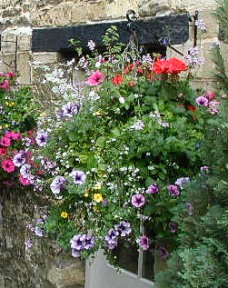
Cyclamen
by Derek Burch
It will soon be the season for all those wonderful cyclamen to be coming into the stores (unless you live in South Florida or nearer the equator, when you can only sigh and envy the people who are digging themselves out of the snow in their driveways).
Florist's cyclamen (Cyclamen persicum) form a storage structure shaped like a flat sphere. This carries them through the times of year when the conditions are not good for growing, which in their case is the hot dry summers of their native Mediterranean region.
When conditions are
right, leaves (and later flowers) grow up from the middle of the tuber,
while a root system is developing from the under side. Once this has happened,
these need just the same care as most houseplants: cool rather than hot
conditions, good light, an occasional shot of dilute fertiliser and a
middle road with watering that never lets them dry out but absolutely
avoids the soil being soggy-wet.
| The water can come from above or below - these plants are so forgiving. And what a joy they are with their crown of attractive flowers surrounded by a ruff of dark leaves. Older varieties are very fragrant, and in fact the extensive breeding programs that have given us a range of sizes from super-minis to giants are now turning their attention to bringing back fragrance. |
 |
 |
These programs have already produced flowers with the upturned petals in a wide range of self-colours and picotees, as well as ruffled and double forms, and now one line of breeding is bringing in beautifully marked leaves to make the plants desirable whether in bloom or not. This actually began in the 1960s when Wye College of the University of London started to hybridise florist's cyclamen with smaller species with marbled leaves and fragrant flowers to bring these characteristics into the crop. More about these species later. |
| Cyclamen persicum with marbled leaves |
For the homeowner, the cyclamen experience usually begins with a plant in full bloom arriving home from a nursery. As already mentioned the plant will be easy to care for provided it can have a coolish spot, free from drafts with good light. The nursery will have chosen a potting medium with plenty of sand and organic matter to ensure that that it drains well, but still holds some water. The tuber will seem almost to be floating on the soil surface, although in fact it is firmly anchored with a root system of fine wiry roots. The nursery will have been feeding the plant regularly, so one or two applications of dilute liquid fertiliser will carry the plant through the winter and early spring, with a continuous replacement of old blooms and leaves by fresh new ones.
As the spring draws into summer, most people find that new flowers are slower to arrive, and eventually the leaves start to droop and yellow as the plant goes into its dormant period. Ocasionally one will go on flowering for a couple of years, but this is unusual.
When the leaves are obviously flagging, the watering should slow down, to the point, eventually, at which the plant is sitting dry in the pot. It can be stored like this, anywhere that it will not be forgotten, until fall. Some people with outside gardens simply sit them in the shade with the pot on its side, and check occasionally for regrowth when the heat of August has passed. The plant can be grown a second year in its same soil, or may be repotted when it is dormant using a similar free-draining/organic rich mix. The storage structure should have about half an inch in the soil and the rest above it.
Once regular watering
begins, the plant will benefit from a regular very dilute feeding program.
It can (and should) be outside, or at least very cool until leaves and
buds are well formed and it can come back in to its place of honour in
the house for the winter season.
 |
These cyclamen, especially the smaller-growing types are now being widely used in winter window boxes and planters. They may be damaged by freezing conditions, but are otherwise very well adapted for this use - which, of course, should remind us of the fact that they really do not like to be in a hot interior, and will be very short-lived under high temperatures. In some areas they have been added successfully to the spectrum of winter annuals, giving color through several fall months. |
Cyclamen persicum may be the most familiar to most people, but many gardeners know and love other species. To read about these go to cyclamen species.
Back to Table of Contents